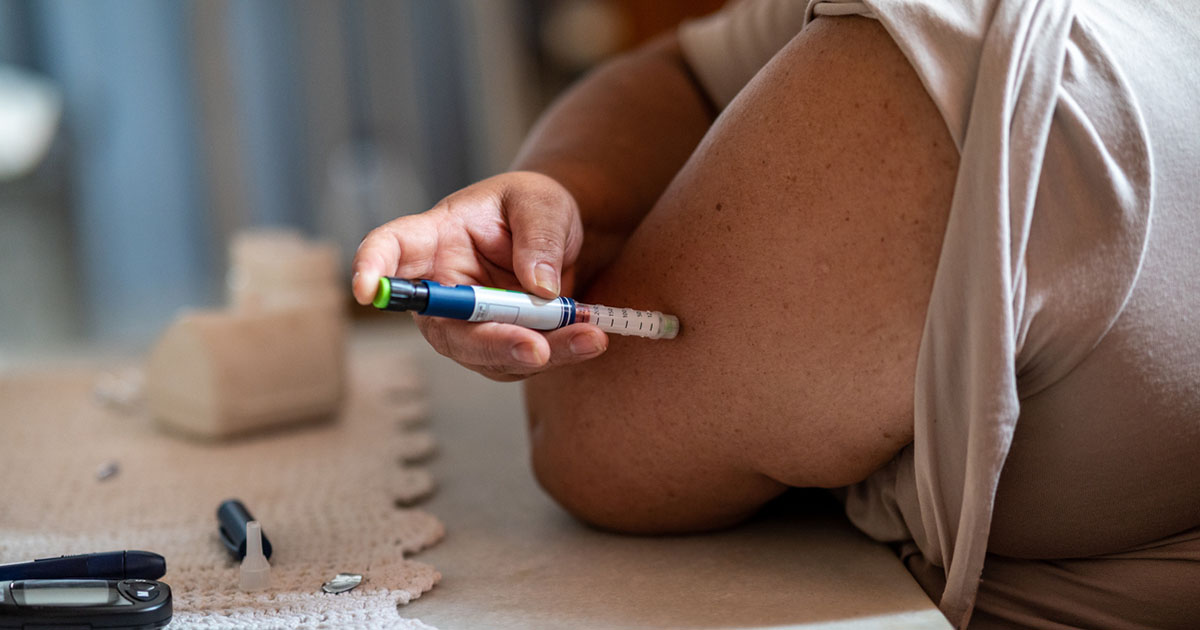Diabetes is one of the greatest health challenges facing the UK today (Diabetes UK, 2012a). There are currently around 3.8 million people living with diabetes in the UK, and this figure is expected to rise to 6.25 million by 2035 (Diabetes UK, 2012b).
The potential burden of diabetes on the NHS is huge, given the host of complications and a lifelong package of care for each person with the condition. Around half of those affected will be from disadvantaged communities, who are less likely to access appropriate structured care or, in the case of offenders, to have access to adequate healthcare. However, this type of environment provides an ideal opportunity to address the health needs of a “hard-to-reach” sector of society with diabetes. For some offenders, prison provides an opportunity to access healthcare which, for a variety of reasons, they have not been able to access previously (Condon et al, 2007). In addition, there are opportunities to promote health within the prison environment (Department of Health [DH] and HM Prison Service, 2002).
The National Service Framework (NSF) for Diabetes: Standards published in 2001 (DH, 2001) made specific reference in Standard 4 to the provision of structured diabetes care for people living in custodial settings. In April 2006, responsibility for medical care for prisoners’ health in England and Wales transferred from the Home Office (now National Offender Management Service, NOMS), which is an agency of the Ministry of Justice (MoJ), to the DH, and hence lies with local primary care trusts (Triggle, 2006).
Diabetes UK issued a position statement in 2005 highlighting the deficiencies in care within prisons, and subsequently published a report on guidance on diabetes care for prisoners with diabetes (Diabetes UK, 2010). The deficiencies included a lack of care planning and case management, inadequate dietary support and inappropriate diet, lack of self-monitoring facilities, lack of specialist health professional input and unstructured medical follow-up practices (Gill et al, 1992).
This study also reported that while some specialists visited prisons, others transported prisoners to hospital for treatment, necessitating security arrangements. This was time-consuming, led to cancelled appointments and avoidance of appointments being made at all. If offenders with diabetes have been poorly looked after in prison, they are at high risk of future complications, which will impact not only on their quality of life and productivity but also on the utilisation of acute hospital and community services.
There is very little published literature about the best ways to provide healthcare in prisons and to inform the setting up of new models of diabetes services that might address the issues identified in the Diabetes UK (2010) report. A nurse-led diabetes clinic in the prison setting was established in Manchester prison (Leivesley and Booth, 2009). Health priorities in prison are driven by high levels of mental health problems, drug misuse and general poor health among prisoners (Bridgwood and Malbon, 1995).
A survey conducted by the Royal College of Nursing (RCN) on the quality of diabetes services in UK prisons (Booles, 2011) showed that, while there were some areas of good practice, generally there were significant deficiencies within the prison for provision of diabetes services. These included lack of education and support for prison staff working with prisoners who have diabetes, leading to a high risk of poor diabetes management. Education for prisoners with diabetes was poor and, where it did exist, focused on diet and exercise and little else. Booles made several recommendations for strategies that could be adopted to improve diabetes services in prisons.
Diabetes service redesign
In 2009, the Wakefield Diabetes Network (Box 1) began implementation of an innovative service redesign to support GP practices in reducing inequalities by delivering high quality specialist diabetes care in the community (Nagi and Wilson, 2011). In December 2010, this model was extended to include HM Prison Wakefield, with the aim of improving clinical outcomes for offenders.
Providing care for people with diabetes in this environment can be challenging. Moreover, care of offenders in prison can be complicated by lack of consistency in the trained staff supporting them, lack of understanding and training for prison officers and food choices that do not fully support a healthy diet, giving offenders little choice.
Benefits of the service redesign
The intended benefits at the start of this redesign were:
- Identifying and addressing the unmet needs of the diabetes population, who were usually cared for in primary care.
- Increased access to appropriate healthcare – more chance of engagement from offenders through provision of diabetes services within the prison environment (“care closer to home” agenda).
- Up-skilling of the prison workforce to enable them to deliver diabetes care within their core role.
In addition, it was known that the new services, by their nature, would also lead to:
- Reduction in the overall cost of the service – PbR (Payment by Results) tariff to the acute trusts, and cost of security, including escorts and transport.
- Potential reduction in emergency diabetes admissions.
- Reduced risk to the public and reduction in disruption at the acute trust from offenders leaving prison under escort.
- Reduction in health inequalities, providing equitable care to those in a prison environment as in primary care (as instructed in DH, 2001).
New model of diabetes service provision
Consultant diabetologist and DSN session (one session per month):
- Case note review.
- Joint specialist clinics in the prison and jointly with prison medical staff.
- Staff education and training.
In the first phase, the diagnosis, complications and management for each prisoner who agreed to be seen were reviewed, with clear follow-up arrangements. Rationalisation of blood glucose testing was also undertaken to ensure that this was done only when needed.
In addition:
A regular dietetic clinic was added to support carbohydrate counting for those with type 1 diabetes and to support healthy eating and weight reduction for those with type 2 diabetes. Menus and meal planning were addressed by the dietitian and chef, and advice was given regarding appropriate choices based on availability in the prison.
Education and training of prison staff: Prison staff have been trained in medication reviews, management of hypoglycaemia and supporting insulin-treated prisoners with carbohydrate counting and insulin titration. The DSN also receives weekly blood glucose readings so that regular titration of insulin and oral antidiabetes drugs can be addressed, leading to improved diabetes control.
More than 90% of offenders have now been reviewed and appropriate management initiated. Annual reviews have been undertaken, with an increase in HbA1c recording and foot examination. Inpatient ward rounds have been developed on the hospital wing, together with education of appropriate staff.
Results
Prevalence of diabetes in HM Prison Wakefield
The total prison population is currently around 745, of whom 71 (9.5%) have diabetes (7% type 1; 93% type 2). The age range and ethnic background of the prisoners with diabetes is given in Tables 1 and 2.
Clinical outcomes
Tables 3 and 4 show the Quality and Outcomes Framework (QOF) performance for HM Prison Wakefield before and after implementation of the new service. Key points are the improvement in blood pressure, glycaemic control and lipid management. A technical problem prevented recording of the QOF score for foot examination, although these were undertaken, as can be seen from the DM10 scores.
Since implementation, there have been no transfers of offenders to hospital-based diabetes clinics and an almost complete avoidance of hospital attendances for hypoglycaemia. Subjectively, prisoners with diabetes report a significant improvement in the service provided and feel that they have been listened to. The development of effective relationships with the diabetes team has improved offenders’ wellbeing and their desire to improve control of their diabetes. Prison staff have felt more confident in supporting prisoners in the management of their diabetes.
Modelling of cost reductions in diabetes healthcare in HM Prison Wakefield
An estimate of the financial cost of providing healthcare to prisoners with diabetes was undertaken to enable comparison of the pre-existing model and the new model. For the calculations, it was assumed that all patients with type 1 diabetes would be cared for at the hospital by a specialist team. For this cohort (n=5), this would mean one new multidisciplinary referral and up to three follow-up appointments at a cost of £3915 tariff and escort costs (£252 x 20 escorts = £5040), totalling £8955.
For those with type 2 diabetes, secondary care clinic utilisation was extrapolated from the data for the non-prison population. Assuming that 40% of offenders with type 2 diabetes would be under shared care equates to 26 offenders having at least two appointments per year. The costs incurred would therefore include 25 new multidisciplinary appointments initially (25 x £297 = £7425) and 25 escort costs (25 x £252 = £6300), totalling £13 752, as well as 25 further follow-up appointments (25 x £162 = £4050) and additional escort costs (25 x £252 = £6300), totalling £10350.
Thus implementation of modern diabetes care for the prison population using a traditional hospital-based specialist service would have cost £33057, whereas delivery of the service in the prison cost £8418. Table 5 shows a summary of the analysis of costs.
Discussion
Review of the new service model has shown that it is possible for specialist teams to work with HM prison staff and prisoners with diabetes to deliver a proactive diabetes care service with minimal planning and expansion of the infrastructure. This is associated with significant cost savings to the health economy and the provision of better-quality diabetes care to all prisoners with diabetes.
Historically, prison healthcare was reactive rather than proactive, and unless an offender with diabetes had an acute problem, his or her care remained in the prison. The introduction of a specialist, multidisciplinary diabetes service into a high-security prison was straightforward and resulted in better clinical outcomes at less overall cost. The new service model has proved popular with prisoners, prison staff and commissioners.
These findings are similar to those of Leivesley and Booth (2009), who showed that the introduction of a nurse-led service into prison improved diabetes care. That model has been extended further at HM Prison Wakefield by provision of a multidisciplinary input into the prison services, led by a consultant diabetologist and DSN. The impact of this in terms of transfer of prisoners with diabetes for routine diabetes care to a specialist hospital clinic has been dramatic: there have been no emergency admissions to hospital with hyperglycaemic or hypoglycaemic syndrome and an improvement in the processes of care.
It is acknowledged that diabetes services are changing across the country (Nagi and Wilson, 2011), but much still needs to be done to improve the quality of care further (Diabetes UK, 2012a; Rayman and Kilvert, 2012). Diabetes services in prisons may have improved since the last RCN survey (Booles, 2011), but it may be time to examine them again. The authors are discussing with the prison services and Diabetes UK how this can be taken forward. Such information will allow an appropriate commissioning of services for prisoners with diabetes. This should help the local health community to reap the putative benefits both in clinical terms and in efficiency gains.
The commissioning of such a service will also break the barriers and deliver integrated diabetes care, such as espoused in a national NHS alliance report in “Teams without Walls” (Royal College of Physicians, 2008). The authors feel that they have made significant strides in achieving this in their locality.
The authors welcome correspondence regarding this article, and Dinesh Nagi can be contacted via email ([email protected]), or via the Edna Coates Diabetes and Endocrine Unit, Pinderfields Hospital, Aberford Road, Wakefield, WF1 4DG.





